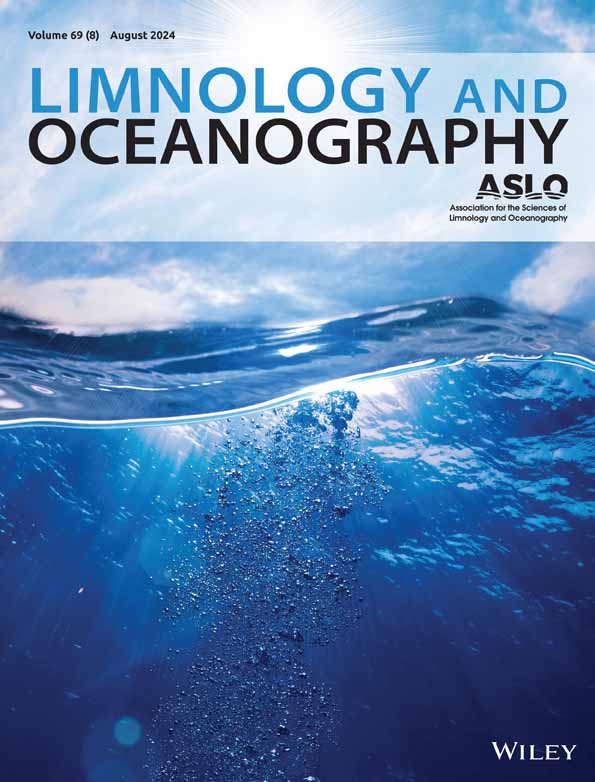水文调节盐沼地下生物量对变暖的响应
IF 3.8
1区 地球科学
Q1 LIMNOLOGY
引用次数: 0
摘要
盐沼提供重要的生态系统服务,包括海岸保护和碳封存。根系在提供这些生态系统服务方面发挥着关键作用,因为它们稳定土壤并促进有机碳积累。本研究考察了在为期3年(2019-2021年)的时间里,温带盐沼中温度升高3°C对三个高程区(先锋区、低沼泽区和高沼泽区)和两种温度处理(环境、+ 3°C)地下生物量动态的影响。高程带反映了不同的水文条件。我们发现,除2019年的高沼泽外,变暖对地下生物量的影响很小,干旱和变暖导致生根深度向更深的方向转移(上层土壤深度为- 53±19%,下层土壤深度为+ 272±129%)。总体而言,高沼泽区根系生物量最低(72.0±94.5 g m−2),低沼泽区最高(360.2±174.7 g m−2),其次是开拓区(218.7±233.8 g m−2)。根系生物量从春季(181.4±183.4 g m−2)上升到秋季(216.5±209.4 g m−2),夏季达到峰值(248.5±235.5 g m−2)。我们的研究结果表明,温度比环境温度升高+ 3℃对根系生物量动态的影响微乎其微,这表明在全球变暖的情况下,土壤的稳定功能和地下对碳封存的贡献可能保持不变。此外,潮汐状态和年际降水模式之间的相互作用似乎对根系生物量的变化起着更重要的作用。本文章由计算机程序翻译,如有差异,请以英文原文为准。
Hydrology mediates salt marsh belowground biomass response to warming
Salt marshes provide vital ecosystem services, including coastal protection and carbon sequestration. Roots play a key role in delivering these ecosystem services, as they stabilize soils and contribute to organic carbon accumulation. This study examines the impact of an experimental 3°C temperature increase in a temperate salt marsh on belowground biomass dynamics across three elevation zones (pioneer zone, low marsh, and high marsh) and two temperature treatments (ambient, + 3°C) over a period of 3 yr (2019–2021). The elevation zones reflect different hydrological conditions. We found minimal effects of warming on belowground biomass, except in the high marsh during 2019, where drought and warming caused a shift to deeper rooting depths (− 53 ± 19% in the upper soil depth, + 272 ± 129% in the lower soil depth). Overall, root biomass was lowest in the high marsh (72.0 ± 94.5 g m−2 ) and highest in the low marsh (360.2 ± 174.7 g m−2 ), followed by the pioneer zone (218.7 ± 233.8 g m−2 ). In all years, root biomass peaked in summer (248.5 ± 235.5 g m−2 ) after rising from spring (181.4 ± 183.4 g m−2 ) and declining in autumn (216.5 ± 209.4 g m−2 ). Our findings suggest that a temperature increase of + 3°C above ambient temperatures has a marginal impact on root biomass dynamics, indicating that soil‐stabilizing functions and belowground contributions to carbon sequestration may remain intact under global warming. Moreover, interactions between tidal regime and interannual precipitation patterns seem to play a more important role for root biomass variations.
求助全文
通过发布文献求助,成功后即可免费获取论文全文。
去求助
来源期刊

Limnology and Oceanography
地学-海洋学
CiteScore
8.80
自引率
6.70%
发文量
254
审稿时长
3 months
期刊介绍:
Limnology and Oceanography (L&O; print ISSN 0024-3590, online ISSN 1939-5590) publishes original articles, including scholarly reviews, about all aspects of limnology and oceanography. The journal''s unifying theme is the understanding of aquatic systems. Submissions are judged on the originality of their data, interpretations, and ideas, and on the degree to which they can be generalized beyond the particular aquatic system examined. Laboratory and modeling studies must demonstrate relevance to field environments; typically this means that they are bolstered by substantial "real-world" data. Few purely theoretical or purely empirical papers are accepted for review.
 求助内容:
求助内容: 应助结果提醒方式:
应助结果提醒方式:


